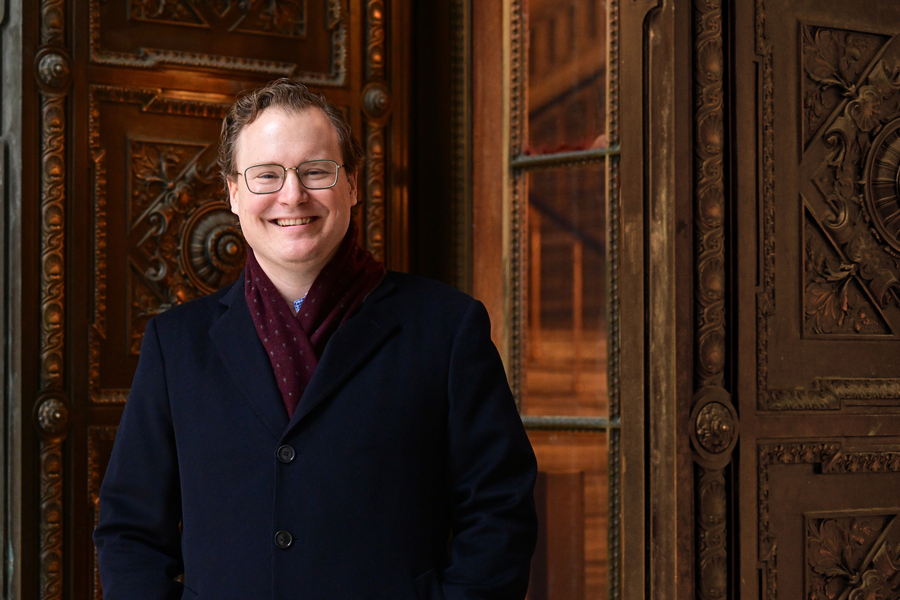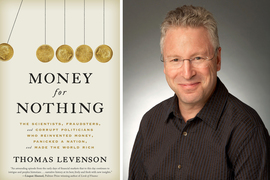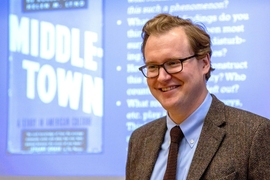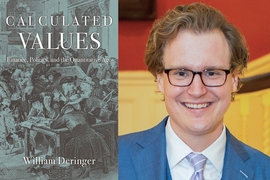Political debates today may not always be exceptionally rational, but they are often infused with numbers. If people are discussing the economy or health care or climate change, sooner or later they will invoke statistics.
It was not always thus. Our habit of using numbers to make political arguments has a history, and William Deringer is a leading historian of it. Indeed, in recent years Deringer, an associate professor in MIT’s Program in Science, Technology, and Society (STS), has carved out a distinctive niche through his scholarship showing how quantitative reasoning has become part of public life.
In his prize-winning 2018 book “Calculated Values” (Harvard University Press), Deringer identified a time in British public life from the 1680s to the 1720s as a key moment when the practice of making numerical arguments took hold — a trend deeply connected with the rise of parliamentary power and political parties. Crucially, freedom of the press also expanded, allowing greater scope for politicians and the public to have frank discussions about the world as it was, backed by empirical evidence.
Deringer’s second book project, in progress and under contract to Yale University Press, digs further into a concept from the first book — the idea of financial discounting. This is a calculation to estimate what money (or other things) in the future is worth today, to assign those future objects a “present value.” Some skilled mathematicians understood discounting in medieval times; its use expanded in the 1600s; today it is very common in finance and is the subject of debate in relation to climate change, as experts try to estimate ideal spending levels on climate matters.
“The book is about how this particular technique came to have the power to weigh in on profound social questions,” Deringer says. “It’s basically about compound interest, and it’s at the center of the most important global question we have to confront.”
Numbers alone do not make a debate rational or informative; they can be false, misleading, used to entrench interests, and so on. Indeed, a key theme in Deringer’s work is that when quantitative reasoning gains more ground, the question is why, and to whose benefit. In this sense his work aligns with the long-running and always-relevant approach of the Institute’s STS faculty, in thinking carefully about how technology and knowledge is applied to the world.
“The broader culture more has become attuned to STS, whether it’s conversations about AI or algorithmic fairness or climate change or energy, these are simultaneously technical and social issues,” Deringer says. “Teaching undergraduates, I’ve found the awareness of that at MIT has only increased.” For both his research and teaching, Deringer received tenure from MIT earlier this year.
Dig in, work outward
Deringer has been focused on these topics since he was an undergraduate at Harvard University.
“I found myself becoming really interested in the history of economics, the history of practical mathematics, data, statistics, and how it came to be that so much of our world is organized quantitatively,” he says.
Deringer wrote a college thesis about how England measured the land it was seizing from Ireland in the 1600s, and then, after graduating, went to work in the finance sector, which gave him a further chance to think about the application of quantification to modern life.
“That was not what I wanted to do forever, but for some of the conceptual questions I was interested in, the societal life of calculations, I found it to be a really interesting space,” Deringer says.
He returned to academia by pursuing his PhD in the history of science at Princeton University. There, in his first year of graduate school, in the archives, Deringer found 18th-century pamphlets about financial calculations concering the value of stock involved in the infamous episode of speculation known as the South Sea Bubble. That became part of his dissertation; skeptics of the South Sea Bubble were among the prominent early voices bringing data into public debates. It has also helped inform his second book.
First, though, Deringer earned his doctorate from Princeton in 2012, then spent three years as a Mellon Postdoctoral Research Fellow at Columbia University. He joined the MIT faculty in 2015. At the Institute, he finished turning his dissertation into the “Calculated Values” book — which won the 2019 Oscar Kenshur Prize for the best book from the Center for Eighteenth-Century Studies at Indiana University, and was co-winner of the 2021 Joseph J. Spengler Prize for best book from the History of Economics Society.
“My method as a scholar is to dig into the technical details, then work outward historically from them,” Deringer says.
A long historical chain
Even as Deringer was writing his first book, the idea for the second one was taking root in his mind. Those South Sea Bubble pamphets he had found while at Princeton incorporated discounting, which was intermittently present in “Calculated Values.” Deringer was intrigued by how adept 18th-century figures were at discounting.
“Something that I thought of as a very modern technique seemed to be really well-known by a lot of people in the 1720s,” he says.
At the same time, a conversation with an academic colleague in philosophy made it clear to Deringer how different conclusions about discounting had become debated in climate change policy. He soon resolved to write the “biography of a calculation” about financial discounting.
“I knew my next book had to be about this,” Deringer says. “I was very interested in the deep historical roots of discounting, and it has a lot of present urgency.”
Deringer says the book will incorporate material about the financing of English cathedrals, the heavy use of discounting in the mining industry during the Industrial Revolution, a revival of discounting in 1960s policy circles, and climate change, among other things. In each case, he is carefully looking at the interests and historical dynamics behind the use of discounting.
“For people who use discounting regularly, it’s like gravity: It’s very obvious that to be rational is to discount the future according to this formula,” Deringer says. “But if you look at history, what is thought of as rational is part of a very long historical chain of people applying this calculation in various ways, and over time that’s just how things are done. I’m really interested in pulling apart that idea that this is a sort of timeless rational calculation, as opposed to a product of this interesting history.”
Working in STS, Deringer notes, has helped encourage him to link together numerous historical time periods into one book about the numerous ways discounting has been used.
“I’m not sure that pursuing a book that stretches from the 17th century to the 21st century is something I would have done in other contexts,” Deringer says. He is also quick to credit his colleagues in STS and in other programs for helping create the scholarly environment in which he is thriving.
“I came in with a really amazing cohort of other scholars in SHASS,” Deringer notes, referring to the MIT School of Humanities, Arts, and Social Sciences. He cites others receiving tenure in the last year such as his STS colleague Robin Scheffler, historian Megan Black, and historian Caley Horan, with whom Deringer has taught graduate classes on the concept of risk in history. In all, Deringer says, the Institute has been an excellent place for him to pursue interdisciplinary work on technical thought in history.
“I work on very old things and very technical things,” Deringer says. “But I’ve found a wonderful welcoming at MIT from people in different fields who light up when they hear what I’m interested in.”












